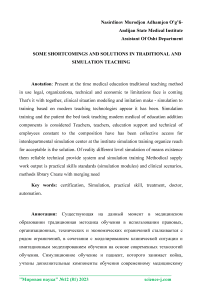Some shortcomings and solutions in traditional and simulation teaching
Автор: Nasirdinov M.A.
Журнал: Мировая наука @science-j
Рубрика: Основной раздел
Статья в выпуске: 12 (81), 2023 года.
Бесплатный доступ
Present at the time medical education traditional teaching method in use legal, organizationa, technical and economic to limitations face is coming That's it with together, clinical situation modeling and imitation make - simulation to training based on modern teaching technologies appear it has been. Simulation training and the patient the bed took teaching modern medical of education addition components is considered Teachers, teachers, education support and technical of employees constant to the composition have has been collective access for interdepartmental simulation center at the institute simulation training organize reach for acceptable is the solution. Of reality different level simulation of means existence them reliable technical provide system and simulation training Methodical supply work output is practical skills standards (simulation modules) and clinical scenarios, methods library Create with merging need
Certification, simulation, practical skill, treatment, doctor, automation
Короткий адрес: https://sciup.org/140302648
IDR: 140302648
Текст научной статьи Some shortcomings and solutions in traditional and simulation teaching
-
1. Simulation of teaching all level medical of education valid to the system integration (from the 1st to the 6th course, as well as at the institute done being increased another education programs ). Dynamic clinical in scenarios help individual elementary in showing of skills up technology to skills and group harmony skills until skill and of skills complexity level increase with simulation study program step by step build
-
2. Mandatory simulation certification system current to achieve By specialty (discipline). practical skill and qualifications from the attestation transfer stage simulation from technologies mandatory used without done increase need
-
3. Teachers, education and technical of employees constant states has been separately students access possible has been simulation center Create. Simulation teaching from technologies use according to teachers-instructors special preparation
-
4. Various level to reality have simulation of means enough quantity and wide assortment buy get their level of realism increase with simulation of teaching technical tools expand need
-
5. Simulation supply, repair and metrological of provision technical tools each day reliable service show system formation, simulation training for expendable materials, that's it including simulators for caution parts and accessories for financial resources planning.
Books
-
1. Evdokimov, E. A. Simulation training and anesthesiology and reanimation / E. A. Evdokimov, I. N. Pasechnik // Simulyatsionnoe obuchenie v meditsine / pod ed. prof. A. A. Svistunova, sost. M. D Gorshkov. - Moscow: Izd-vo Pervogo MGMU im. I. M. Sechenova, 2013. – S. 146.
-
2. Gorshkov, M. D. Classification of simulation equipment / M. D Gorshkov, A. V. Fedorov // Virtual technology and medicine. – 2012. – No. 1. – S. 21-30.
-
3. Shubina, L. B. Imitatsionnoe buchenie v tsentre non-preryvnogo professionalnogo obrazovaniya v struktur meditsinskogo universiteta / L B. Shubina // Medical education and professional development. – 2011 – No. 3. – S. 85-91.
Список литературы Some shortcomings and solutions in traditional and simulation teaching
- Evdokimov, E. A. Simulation training and anesthesiology and reanimation / E. A. Evdokimov, I. N. Pasechnik // Simulyatsionnoe obuchenie v meditsine / pod ed. prof. A. A. Svistunova, sost. M. D. Gorshkov. - Moscow: Izd-vo Pervogo MGMU im. I. M. Sechenova, 2013. - S. 146.
- Gorshkov, M. D. Classification of simulation equipment / M. D. Gorshkov, A. V. Fedorov // Virtual technology and medicine. - 2012. - No. 1. - S. 21-30.
- Shubina, L. B. Imitatsionnoe buchenie v tsentre non-preryvnogo professionalnogo obrazovaniya v struktur meditsinskogo universiteta / L. B. Shubina // Medical education and professional development. - 2011. - No. 3. - S. 85-91. EDN: ORDHCL


